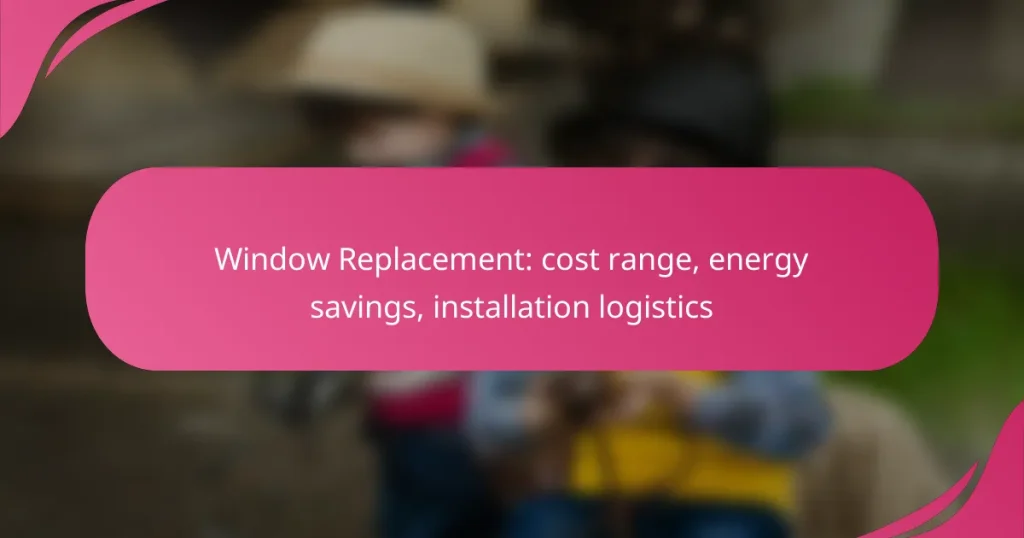Replacing windows can be a significant investment, with costs in Canada typically ranging from CAD 300 to CAD 1,000 per window, influenced by factors like type and installation complexity. Beyond the initial expense, modern energy-efficient windows can lead to substantial long-term savings on heating and cooling costs, enhancing overall home comfort. Additionally, homeowners should be aware of the logistical aspects of installation, including the necessary permits and timeframe, to ensure a smooth replacement process.

What is the cost range for window replacement in Canada?
The cost range for window replacement in Canada typically falls between CAD 300 to CAD 1,000 per window, depending on various factors such as type, size, and installation complexity. Homeowners should consider both the upfront costs and potential long-term energy savings when planning a window replacement project.
Average cost per window
The average cost per window in Canada generally ranges from CAD 400 to CAD 800. This price includes both the window itself and installation fees. Higher-end windows with advanced features can exceed this range, while basic models may be available for less.
Factors affecting cost
Additionally, labor costs vary by region and contractor experience, which can further affect overall expenses. Homeowners should obtain multiple quotes to ensure competitive pricing.
Cost comparison by window type
Different window types come with varying costs. For instance, vinyl windows are often the most affordable, typically ranging from CAD 300 to CAD 600. Wood windows, while aesthetically pleasing, can cost between CAD 600 and CAD 1,200 due to their materials and maintenance needs.
Energy-efficient windows, such as double or triple-pane options, may have higher initial costs but can lead to significant savings on energy bills over time. These windows usually start around CAD 500 and can go up to CAD 1,500 or more.
Regional price variations
Window replacement costs can vary significantly across Canada due to regional labor rates and market demand. For example, urban areas like Toronto and Vancouver may have higher installation costs compared to smaller towns or rural regions.
Homeowners should research local pricing trends and consider seasonal factors, as demand for window replacements can fluctuate throughout the year, potentially affecting costs. It’s advisable to plan projects during off-peak seasons for better pricing and availability.

How can window replacement lead to energy savings?
Window replacement can significantly enhance energy efficiency by reducing heat loss in winter and minimizing heat gain in summer. By upgrading to modern, energy-efficient windows, homeowners can lower their heating and cooling costs while improving indoor comfort.
Energy-efficient window options
When considering window replacement, energy-efficient options include double or triple-pane glass, low-emissivity (Low-E) coatings, and gas fills like argon or krypton. These features help to insulate the home better, reducing the need for heating and cooling systems to work harder.
Look for windows that meet ENERGY STAR® ratings, which indicate superior energy performance. Selecting windows with a high R-value and low U-factor can further enhance energy savings.
Potential savings on energy bills
Replacing old windows with energy-efficient models can lead to noticeable reductions in energy bills, often ranging from 10% to 25%. The exact savings depend on factors such as the local climate, the type of windows installed, and the home’s overall energy efficiency.
Homeowners can expect a return on investment over time, with many recouping their initial costs through lower utility bills within a few years. It’s advisable to calculate potential savings based on local energy rates and usage patterns.
Long-term environmental benefits
Energy-efficient windows contribute to reduced energy consumption, which in turn lowers greenhouse gas emissions. By using less energy for heating and cooling, homeowners can play a part in combating climate change and promoting sustainability.
Additionally, many regions offer incentives for energy-efficient upgrades, further encouraging environmentally friendly choices. Investing in energy-efficient windows not only benefits the homeowner but also supports a healthier planet for future generations.

What are the installation logistics for window replacement?
Window replacement involves several logistical considerations, including the installation process, timeframe, and necessary permits. Understanding these aspects can help ensure a smooth and efficient replacement experience.
Installation process overview
The installation process for window replacement typically begins with an assessment of the existing windows and a measurement of the new ones. This is followed by the removal of old windows, preparation of the opening, and installation of the new windows, which may include sealing and insulation to enhance energy efficiency.
It’s crucial to choose the right type of windows and materials based on your climate and home design. Common options include double-hung, casement, and sliding windows, each offering different benefits in terms of aesthetics and functionality.
Timeframe for installation
The timeframe for window replacement can vary widely, generally ranging from a few hours to a couple of days, depending on the number of windows being replaced and the complexity of the installation. For a standard home with several windows, expect the process to take one to two days.
Factors that can affect the installation time include weather conditions, the condition of the existing window frames, and any additional work required, such as repairs to the surrounding structure.
Permits and regulations in Canada
In Canada, window replacement may require permits, especially if the project involves structural changes or affects the exterior appearance of the home. Regulations can vary by province and municipality, so it’s essential to check local building codes before starting the project.
Homeowners should consult with local authorities or a licensed contractor to ensure compliance with all regulations. This can help avoid potential fines and ensure the work meets safety standards.

What are the prerequisites for window replacement?
Before replacing windows, homeowners should assess their current windows’ condition, energy efficiency, and the overall home structure. Understanding local building codes and regulations is also essential to ensure compliance during the installation process.
Home assessment criteria
Begin by evaluating the existing windows for signs of damage, such as cracks, leaks, or condensation between panes. Consider the age of the windows; older models may not meet current energy efficiency standards and could be costing you more in heating and cooling bills.
Next, assess the home’s insulation and overall energy performance. A home energy audit can help identify areas where improvements are needed, which may influence the type of windows you choose. Look for windows with a good energy rating to maximize savings on utility bills.
Choosing the right contractor
Selecting a qualified contractor is crucial for a successful window replacement. Start by researching local contractors with experience in window installation and check their reviews and references. Ensure they are licensed and insured to protect yourself from potential liabilities.
Request detailed quotes from multiple contractors, comparing not just prices but also the materials and warranties offered. A reliable contractor should provide a clear timeline for the project and be willing to answer any questions you may have about the installation process. Avoid contractors who pressure you into quick decisions or offer unusually low prices, as this may indicate subpar work or materials.

What are the benefits of different window materials?
Different window materials offer various benefits, impacting durability, energy efficiency, and maintenance. Choosing the right material can enhance your home’s comfort and reduce long-term costs.
Vinyl vs. wood windows
Vinyl windows are known for their low maintenance and energy efficiency, often costing less than wood options. They resist moisture and do not require painting, making them a practical choice for many homeowners.
Wood windows, while more expensive and requiring regular maintenance, provide excellent insulation and aesthetic appeal. They can be customized easily and offer a classic look that many prefer, especially in historic homes.
Aluminum window advantages
Aluminum windows are lightweight, strong, and resistant to corrosion, making them suitable for various climates. They typically have a lower upfront cost compared to wood and can be finished in a variety of colors.
However, aluminum conducts heat, which can lead to energy loss. To mitigate this, look for thermally broken aluminum frames that improve insulation. This option balances durability with energy efficiency, making it a solid choice for modern homes.

How do window replacement warranties work?
Window replacement warranties typically cover defects in materials and workmanship for a specified period. They can vary significantly in terms of duration and coverage, so understanding the details is essential for homeowners.
Types of warranties
There are generally two main types of warranties for window replacements: manufacturer warranties and labor warranties. Manufacturer warranties cover the window itself, including issues like seal failure or frame defects, while labor warranties cover the installation work performed by contractors.
Manufacturer warranties can last anywhere from a few years to a lifetime, depending on the brand and product. Labor warranties usually range from one to ten years, depending on the contractor’s policies.
What to look for in a warranty
When evaluating window replacement warranties, consider the coverage details, including what is included and excluded. Look for warranties that cover both parts and labor, as well as those that offer transferable options if you decide to sell your home.
Additionally, check for any limitations or conditions that might void the warranty, such as improper installation or lack of maintenance. A strong warranty should provide peace of mind and protection against unexpected repair costs.
Common pitfalls
One common pitfall is assuming that all warranties are the same. Always read the fine print to understand the specific terms and conditions. Another mistake is neglecting to register the warranty, which can be required for it to remain valid.
Homeowners should also be cautious of warranties that seem too good to be true, as they may come with hidden exclusions. Always compare warranties from different manufacturers and contractors to ensure you are getting the best coverage for your investment.


